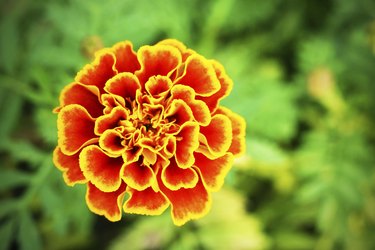
For many gardeners, marigolds (Tagetes spp.) evoke memories of their first experience growing flowers from seeds. These dependable, easy-care annuals continue to delight new generations. Native to the Americas, marigolds traveled to the Eastern Hemisphere to pick up their common names and popularity. Though 40 species exist, two are behind most marigold varieties in the United States -- the center of marigold breeding.
Marigold Types
Video of the Day
Classically compact, French marigolds (Tagetes patula) range from yellow to mahogany red -- with bicolors, oranges and golds between. From simple singles to carnationlike doubles, they grow 6 to 14 inches tall with 1- to 2 1/2-inch blooms. African marigolds (Tagetes erecta) carry 3- to 4 1/2-inch flowers on stems up to 40 inches tall. Always solid colors and never mahogany, these excellent cut flowers span white to orange. Hybrid marigolds (Tagetes x hybrida) from these two parents combine their best traits. The sterile cultivars produce no seeds and focus on prolific blooms instead. Hybrids grow 10 to 16 inches tall with 2- to 2 1/2-inch blossoms in all their parents' colors and forms.
Video of the Day
Easy-Growing Blooms
Marigolds didn't become garden favorites by being fussy flowers. They do best in poor soil, as long as it's well-drained. The large seeds of French marigolds can be seeded directly in your warm, moist garden as soon as soil reaches 70 degrees Fahrenheit. They'll sprout within days, and you'll have seedlings in two weeks. Depending on the variety and your weather, cheery blooms appear four to 10 weeks after that. African marigolds prefer an early start and do best from transplants or started indoors six to eight weeks before moving outside. Transplant on an overcast day, after danger of frost has passed.
Unwanted Garden Guests
Tales abound of marigolds repelling deer, rabbits and other pests. Researchers have yet to substantiate those claims, but marigolds do repel something more sinister. Root-knot nematodes are microscopic, soil-dwelling worms that plague popular garden vegetables. They leave roots of tomatoes (Lycopersicum esculentum) and other crops in knobby, infected messes. Some French marigold cultivars produce root chemicals that reduce harmful nematodes in and around marigold roots. The key isn't planting marigolds next to tomatoes but planting them the season before. Marigolds must be in the garden for at least two months and then tilled into the soil. Nematode-fighting cultivars include "Tangerine," "Goldie," "Petite Gold," "Petite Harmony" and the aptly named "Nema-gone."
Marigold Pests and Disease
Spider mites often infect marigolds stressed by hot, dry, dusty weather. Fight mites with a strong water blast and rinse off dusty marigolds. Shower your flowers in early morning so foliage dries by night. If mites persist, use ready-to-use insecticidal soap. Spray well so mites and soap make contact. Leafhoppers transmit aster yellows, a disease that leaves marigolds pale and stunted, with failing buds. Infected plants should be destroyed. The fungal disease botrytis bothers marigolds during cool, moist weather near season's end. Spread by wind and water, the gray mold spores cause brown, dying marigold petals. Removing affected flowers helps limit the spread.
- National Garden Bureau Inc.: 2010: Year of the Marigold
- Burpee: All About Marigolds
- Clemson Cooperative Extension: Root-Knot Nematodes in the Vegetable Garden
- University of Florida IFAS Extension: Some Help From Marigolds
- Iowa State University Extension and Outreach: Yard and Garden: Marigolds
- University of California Statewide Integrated Pest Management Program
- Pacific Horticulture: The Marigold in California